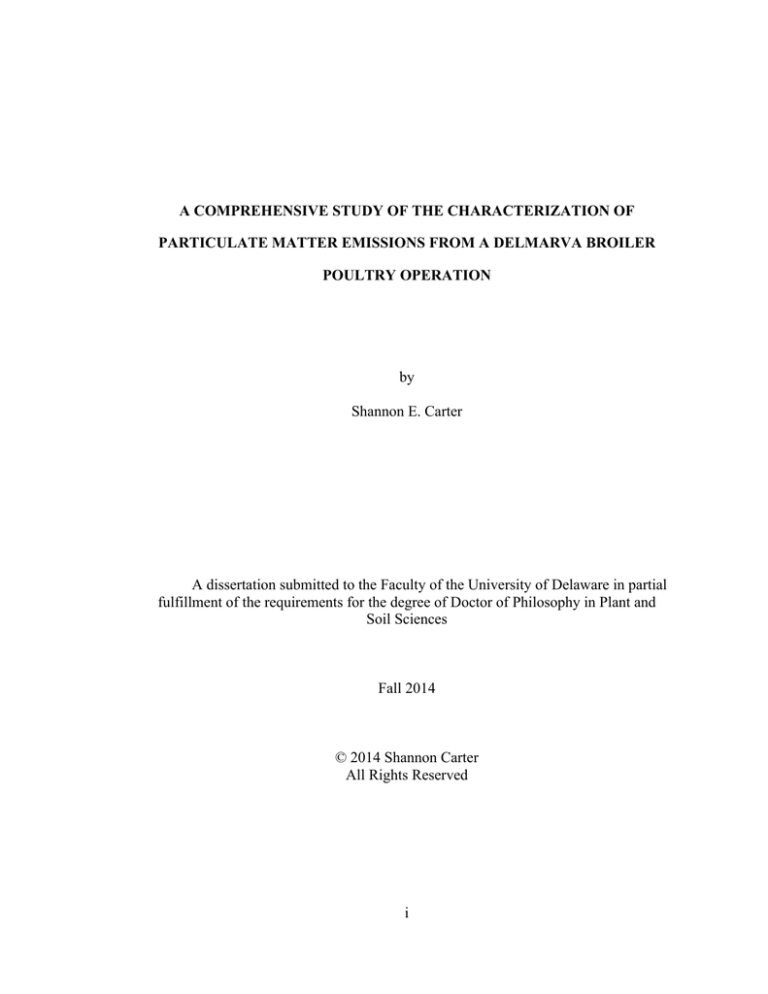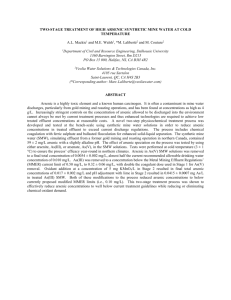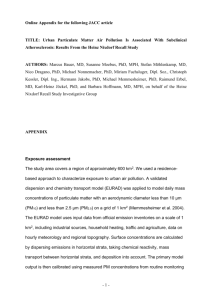
A COMPREHENSIVE STUDY OF THE CHARACTERIZATION OF
PARTICULATE MATTER EMISSIONS FROM A DELMARVA BROILER
POULTRY OPERATION
by
Shannon E. Carter
A dissertation submitted to the Faculty of the University of Delaware in partial
fulfillment of the requirements for the degree of Doctor of Philosophy in Plant and
Soil Sciences
Fall 2014
© 2014 Shannon Carter
All Rights Reserved
i
ABSTRACT
Particulate matter (PM) emissions from agricultural practices, including those
from animal feeding operations (AFO’s) have become an increasingly important topic,
and has generated considerable interest from local and state agencies, as well as, the
local community over the past decade. Because of growth in population, and an
increase in commercial and residential development within close proximity to these
operations, which house a large number of animals in confinement, and because of a
better understanding of the effects of exposure to airborne contaminants on health, this
has lead to an increase in concerns and a demand for more research to be conducted on
PM from AFO’s.
Particulate matter generated within, and emitted from, AFO’s can carry with it
various components including metals and microorganisms that can negatively affect
health. This research was conducted in order to verify if PM from a broiler poultry
operation on Delmarva has the potential to become a health concern. The first step
was to determine concentrations of two size segregated fractions of PM from indoor
and outdoor sampling sites over four seasonal periods, early summer (ES), late
summer (LS), Fall (F), and Winter (W). Both PM10 and PM2.5 were collected because
of their classification from the Environmental Protection Agency as having the ability
to cause significant health effects with short-term exposure. Next, temporal and
spatial characteristics were investigated to determine their effects on PM
concentrations over the four seasonal periods. Following this, the chemical
composition and morphology of PM10 and PM2.5 generated from the broiler poultry
ii
operation was investigated. Finally, further detailed information was obtained on
arsenic speciation and oxidation state in PM to investigate toxicity. Arsenic use in the
poultry industry has been occurring for a number of decades, and is most frequently
administered in the organic form. However, studies have shown that these organoarsenicals can quickly degrade into organic by-products, methylated arsenicals, and
inorganic arsenic (III and V). Because oxidation state determines mobility and
toxicity in humans, animals, and the environment this is a key reason to investigate it
further in PM.
The results from this research indicate that the concentrations of both PM size
segregated fractions that were sampled are within the regulatory guidelines of EPA
and OSHA. Outdoor concentrations were mainly influenced by wind speed changes
over the seasonal periods, and bird weight was the main management factor
influencing indoor PM concentrations. In addition, upon performing chemical
analysis on the PM using inductively coupled plasma mass spectrometry (ICP-MS),
the arsenic concentrations found are not above background ambient arsenic levels for
outdoor samples; however, total arsenic was found to be above those background
concentrations in both indoor PM10 and PM2.5 samples. Although the arsenic
concentrations were found to be higher than background inside the poultry operation,
they are currently within the regulated limits set by the Occupational Safety and
Health Administration (OSHA) and the National Institute of Occupational Safety and
Health (NIOSH). Other metal(loid)s such as copper, manganese, and zinc were also
within regulatory limits in both indoor PM10 and PM2.5 samples.
While the EPA has National Ambient Air Quality Standards set for PM10 and
PM2.5, these regulations are not suitable when evaluating indoor occupational
iii
concentrations from an animal feeding operation such as a broiler poultry operation.
In addition, the EPA does not currently have standards set for arsenic in ambient or
general air pollution. It is also questionable to use the current dust regulations set by
the OSHA or NIOSH because they are generalized to two categories that are not easily
translatable to the current PM10 and PM2.5 size segregations accepted under the EPA.
In addition, there is an assumption made that particles within their total suspended and
respirable regulatory categories are “inert” or nuisance, which infers that particles
under this classification would not lead to any significant health problems. This is not
the case with PM generated from a broiler poultry operation, which can carry with it a
number of contaminants that have been proven to cause various health disorders from
exposure. These classifications also apply to inhalable arsenic standards and are also
questionable when determining whether arsenic concentrations in PM from a poultry
operation are permissible.
Arsenic oxidation state and speciation in PM10 and PM2.5 was investigated
using X-ray absorption spectroscopy (XAS) and X-ray fluorescence (XRF)
spectroscopy. The results indicate that there is a mix of organic species present, as
well as, oxidized As(V) and reduced As(III) in all samples analyzed. The main
organic species found were in the form of Roxarsone, 4-hydroxy-3aminophenylarsonic acid (HAPA), and dimethylarsinic acid (DMA(V)). This
indicates that much of the organic form that was originally administered has degraded
into more toxic by-products that are then becoming incorporated into airborne
particulate matter.
iv
1








